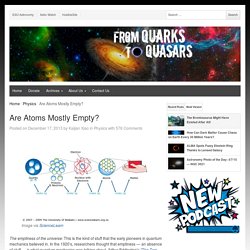

Are Atoms Mostly Empty? - From Quarks to Quasars. The emptiness of the universe: This is the kind of stuff that the early pioneers in quantum mechanics believed in.

In the 1920’s, researchers thought that emptiness — an absence of stuff — is what quantum mechanics was talking about. Arthur Eddington’s “The Two Tables” is a really nice treatment of the subject. In this piece, Eddington essentially argues that there are two tables: First, there is the table of everyday experience. It is a table that we can see and interact with. It is comparatively permanent, it is coloured, and (above all) it is substantial. However, this metaphor happens to be wrong. Are Atoms Mostly Empty? - From Quarks to Quasars. Kinds of Organic Compounds. Updated January 18, 2015.

Carbohydrates are organic compounds made of the elements carbon, hydrogen, and oxygen. The ratio of hydrogen atoms to oxygen atoms in carbohydrate molecules is 2:1. Organisms use carbohydrates as energy sources, structural units, as well as for other purposes. Carbohydrates are the largest class of organic compounds found in organisms. Carbohydrates are classified according to how many subunits they contain. Carbohydrate Examples glucose fructose sucrose (table sugar) chitin cellulose glucose Learn more about carbohydrates. 10 Radioactive Everyday Products. 10 Molecules You Don't Want To Mess With (Dangerous Chemicals) Cheap Drinking Water From The Sun, Aided By A Pop Of Pencil Shavings : Goats and Soda. Solar sponge: The top layer of graphite soaks up the sun's energy in tiny holes.

Building Me: A Puzzlement : Krulwich Wonders... New transparent solar cells can be used on windows, smartphone screens (Science Alert) This new type of transparent solar cell can be used to cover windows, buildings or smartphone screens to produce solar energy.

Named a transparent luminescent solar concentrator and developed by researchers in Michigan State University in the US, this material can be used to cover anything that has a flat, clear surface. Transparent solar cell technology has been attempted before, but the energy the cells produced was poor and the materials they were made out of were highly coloured. "No one wants to sit behind coloured glass,” said one of the researchers behind the technology, chemical engineer Richard Lunt, in a press release.
"It makes for a very colourful environment, like working in a disco. We take an approach where we actually make the luminescent active layer itself transparent.” The new transparent solar cells are made from tiny organic molecules that absorb invisible wavelengths of sunlight such as ultraviolet and near infrared light. What Is the Most Flammable Chemical? Question: What Is the Most Flammable Chemical?

If something is flammable, that means it is capable of catching on fire. For some reason, the word "inflammable" means the same thing. Pitch, err, this: World's longest-running experiment finally drops. First for world's longest running lab experiment A little over 83 years since its inception, the "pitch-drop experiment" at the University of Queensland has finally been captured on camera producing the result scientists have been waiting for. 23, 2014 The world's longest-running laboratory experiment has finally delivered a result – eight months after the man who patiently watched over it unrewarded for five decades died.

Make Your Own Graphene With Just a Blender. Researchers unveiled the process for producing hundreds of liters of a solution containing graphene sheets -- it’s so simple, it can be replicated using household appliances (but to be quite honest, you probably shouldn’t actually try this at home).

The ability to make large quantities of the cheap, good-quality carbon sheet that’s only an atom thick will boost its deployment in various commercial applications, from low-cost flexible electronic displays to filler material in plastic bottles. A team led by Jonathan Coleman from Trinity College Dublin transformed flakes of graphite into graphene solutions using commercially available tools: high-shear mixers and kitchen blenders. What’s New in 3D Printing? 3D Printing is Coming to Our Lives!

3D printing is not a novelty, it is more than 20 years old. However, the first monograph on it has only just appeared [1]. I learned about it only recently, when this manufacturing technique made its way into chemistry [2,3]. Today, rapidly developing 3D printing offers numerous marketed applications. It will bring much more in the future and its potential huge impact on society is hard to grasp. Figure 1. The article “Print me a Stradivarius” with a cover picture of a printed violin was published in The Economist two years ago [8, 9]. MIT's Freaky Non-Stick Coating Keeps Ketchup Flowing. When it comes to those last globs of ketchup inevitably stuck to every bottle of Heinz, most people either violently shake the container in hopes of eking out another drop or two, or perform the "secret" trick: smacking the "57" logo on the bottle’s neck.

But not MIT PhD candidate Dave Smith. He and a team of mechanical engineers and nano-technologists at the Varanasi Research Group have been held up in an MIT lab for the last two months addressing this common dining problem.